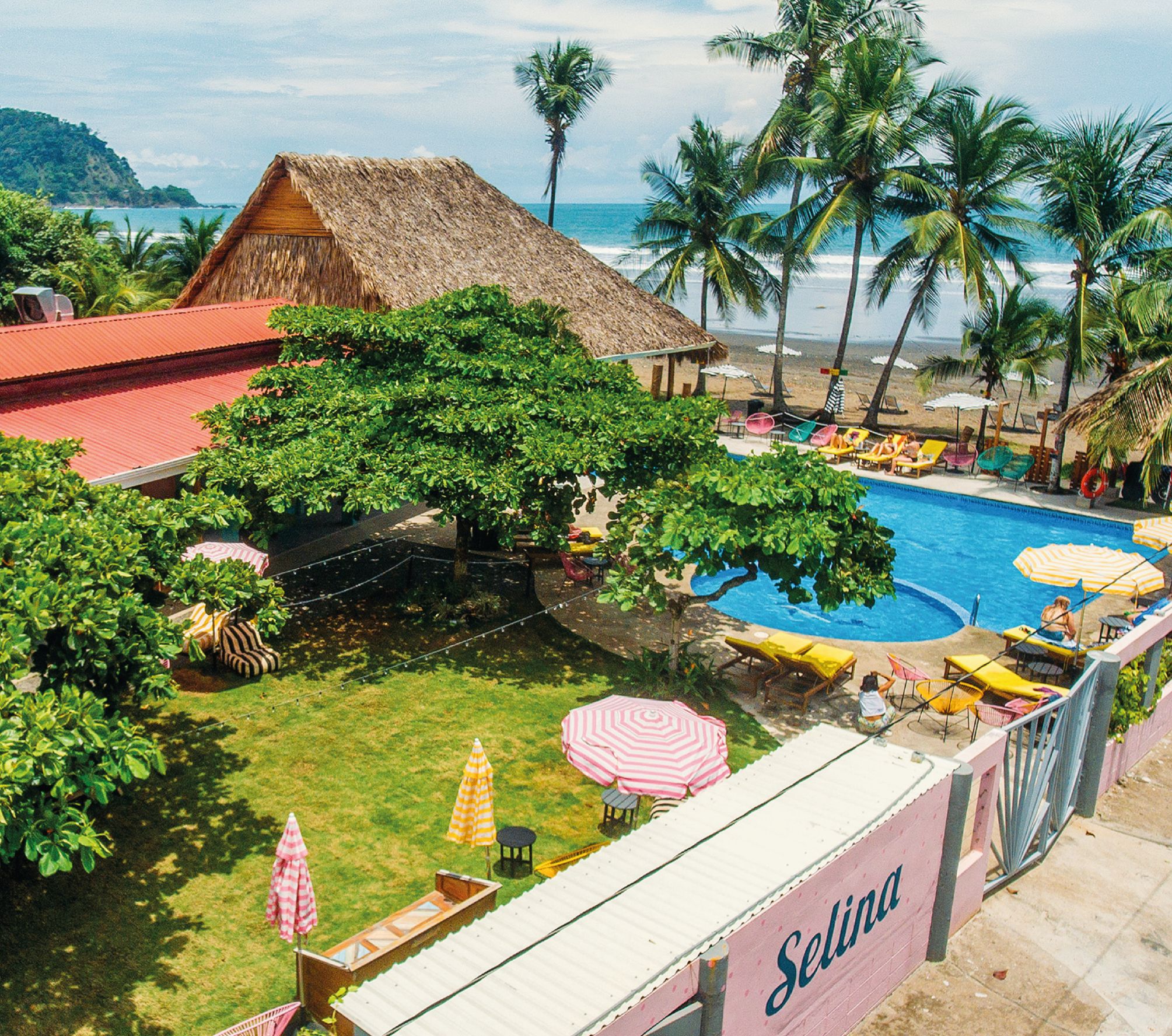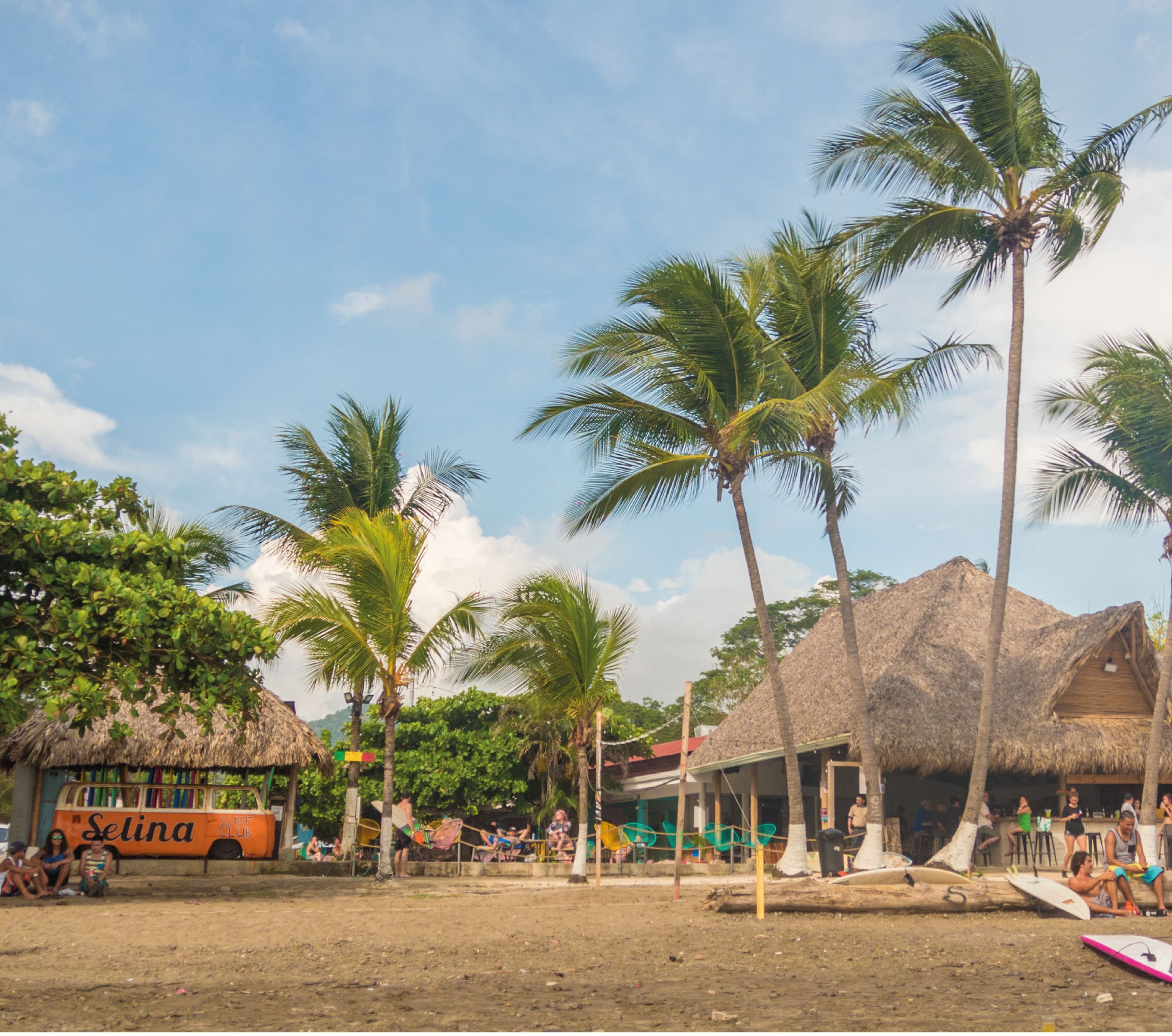What’s the Best Time to Visit Costa Rica? Your Complete Guide
It’s a question we hear constantly: What’s the best time to go to Costa Rica? The truth is that there’s no one-size-fits-all answer. For example, those who want to see the rain forests in all their glory will have the most enjoyable experience during or shortly after the rainy season, while those who want nothing but sunny days at the beach should look at travel dates that fall during the dry season.
Our complete guide covers Costa Rica weather by month and provides insight into festivals, events, and more, making it easier to determine your personal best time to visit Costa Rica.

Enjoy beautiful accommodation, coworking spaces, and the ultimate community experience at Selina Jaco!
In this guide, we'll take a look at:
- 1. Costa Rica Climate Basics
- 2. Costa Rica Weather Patterns and the Green vs. Dry Season: Average Monthly Outlook
- 3. The Cheapest Time to Visit Costa Rica
Costa Rica Climate Basics
Like many other countries, Costa Rica climate varies by location. You’re likely to experience cooler temperatures as you reach higher elevations, further inland around cities like San Jose and La Fortuna, and even more so in the cloud forest of Monteverde.
Coastal regions enjoy a warmer climate in general, but there are differences between the Caribbean and Pacific coasts. The entire Caribbean coast experiences heat, humidity, and rain throughout most of the year, with some drier, cooler days during September and October. In contrast, Costa Rica’s Pacific coast is a bit cooler and drier to the north, closer to Tamarindo, with slightly warmer temperatures and higher humidity around Santa Teresa, Jaco, and locations further to the south.
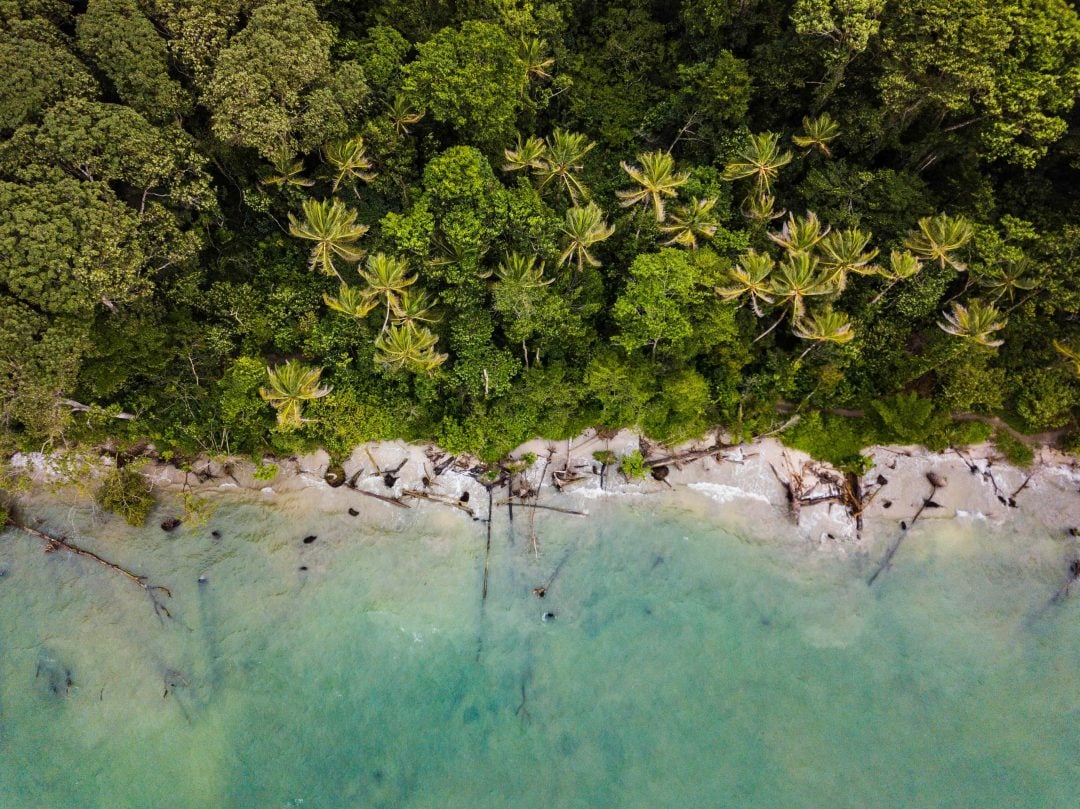
Throughout most of Costa Rica, the dry season begins in December and comes to a close by the end of April, with shoulder months at either end of the spectrum. The seasons are typically opposite in Arenal and the Caribbean.
Since there’s so much variety, it’s a very good idea to check local forecasts for timely insight into specific Costa Rica climate details for the region you plan to visit so you’ll know more about what to expect during your stay.
If you’re looking for a hostel in San Jose to start off your adventure, Selina is conveniently located just steps away from all the main touristic attractions the city has to offer.
Costa Rica Weather Patterns and the Green vs. Dry Season: Average Monthly Outlook
Thanks to the tropical Costa Rica climate, there are only two seasons here: The green season and the dry season. Many visitors feel that the dry season is the best time to visit Costa Rica as days are typically sunny and warm, with no rain in sight. The green season holds more appeal for others. For example, those who are looking for the cheapest time to visit Costa Rica may find that everything from flights to hotel rooms are discounted when there’s a greater likelihood of wetter weather. Since the green season typically brings clear mornings and rainy afternoons, it’s best to plan excursions for the first half of the day.
Since Costa Rica has many different microclimates, it’s very important to double-check. Our monthly guide provides a general outlook and overall average temperatures in Costa Rica on a month by month bases. At the same time, it’s well worth noting that there are definite differences from one locale to the next.
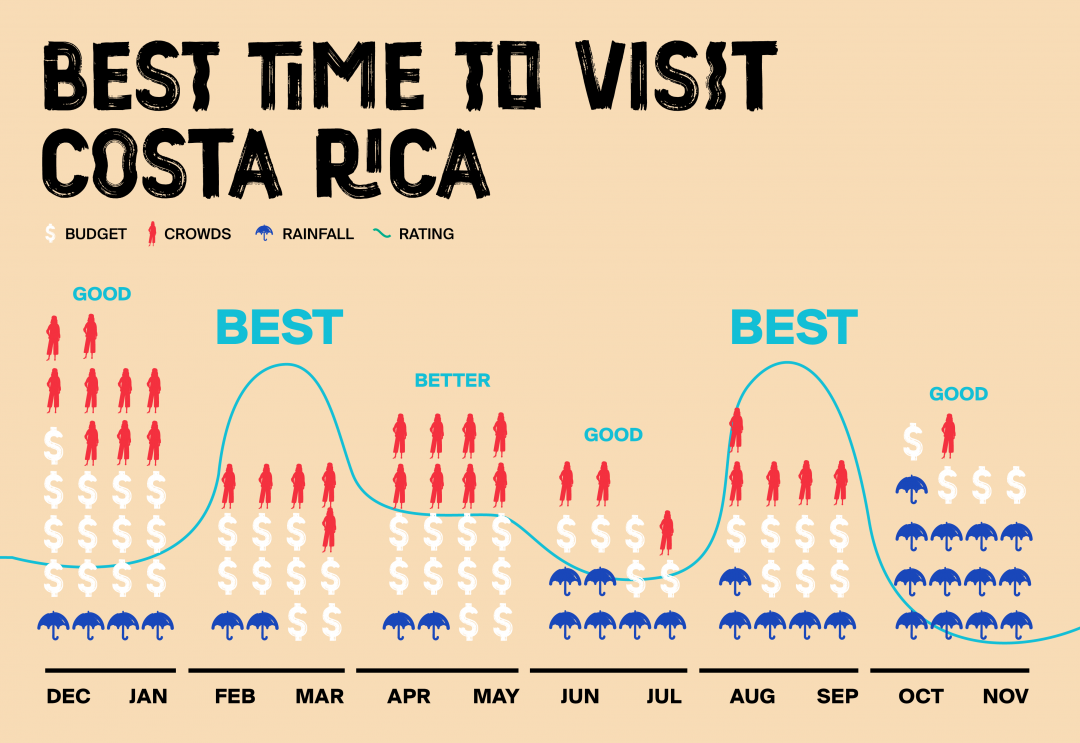
Weather in January: Best Time to Visit Costa Rica Overall
Average temperatures: 63F to 79F
Many people feel that January is the best time to visit Costa Rica, as it is clear and dry. Occasional rainfall keeps landscapes looking lush while reminding everyone that the green season recently came to a close. If you’re planning to visit Nosara or another destination in the Guanacaste region, this might be the ideal time as it’s often very dry. In contrast, it’s one of the wettest months for cities on the northern Caribbean coast. You can also use this time to check out a yoga hotel in Santa Teresa and spend some time stretching into a few different poses for a wellness-inspired retreat.
Weather in February: Best Time for Visiting Mount Arenal
Average temperatures: 64F to 84F
While North America and Europe are in midwinter’s icy grip, Costa Rica enjoys lots of warm, sunny days throughout February. It’s officially the dry season, and the outdoors beckons all around the clock. If you’re sick of winter, this might be the best time to go to Costa Rica!
Weather in March: Best Time to Hit Beaches on the Pacific Coast
Average temperatures: 64F to 86F
With March comes more beautiful, dry weather – just in time for Easter and spring break! If you’re among those who feel as if this is the best time to visit Costa Rica, be sure to plan well in advance. Book excursions and hotels early. Since some venues charge more during peak travel dates, this might be the worst time to visit Costa Rica so far as your budget is concerned.
Weather in April: Best Time to Start Surfing in Costa Rica
Average temperatures: 66F to 86F
As the dry season comes to an end, April treats Costa Rica’s visitors to hotter temperatures and plenty of dry weather. The landscape is less lush this time of year, particularly along the northern portion of the Pacific coast where humidity tends to be lower. Surfing can be enjoyed year-round but the waves are at their best from April through December. If you’re looking to make the most out of this time, we recommend looking for a beach hotel in Jaco like Selina, or a hotel in Santa Teresa, Costa Rica, to stay close to the waves.

Enjoy beautiful accommodation, coworking spaces, and the ultimate community experience at Selina Jaco!
Or, if you’d prefer, you can also book a hotel near Playa Guiones, in Nosara, to test the waves at this surfer’s paradise.
Check out our guide to the best surf spots in Costa Rica for additional details about the best beach breaks and surfing conditions
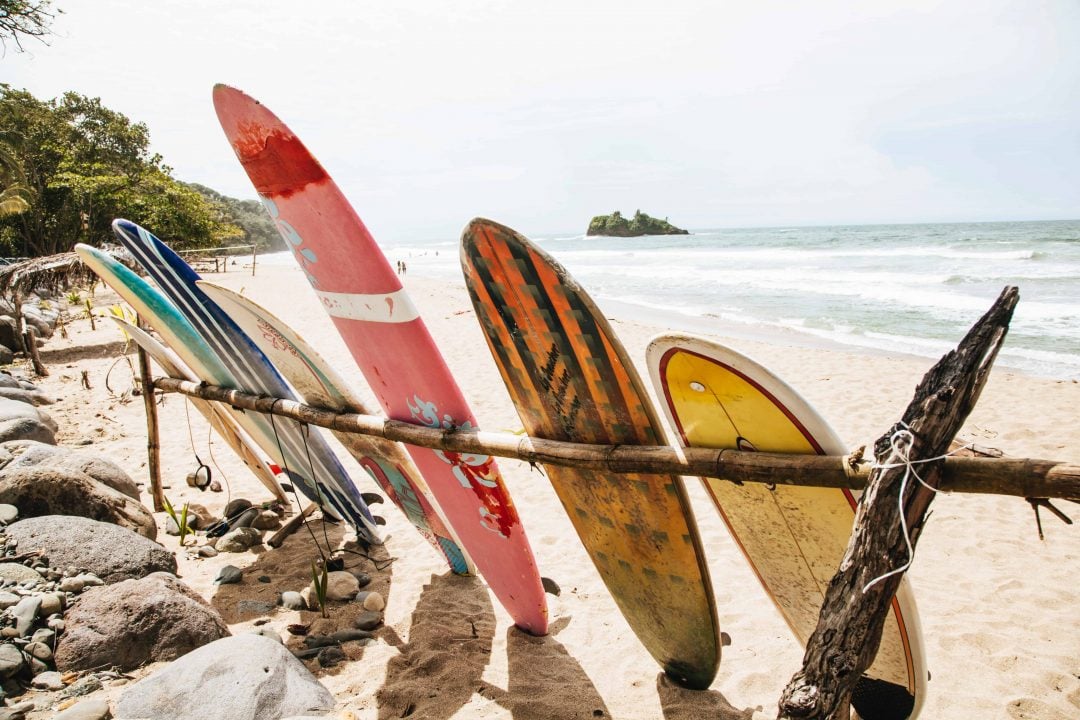
Weather in May: Best Time for Costa Rica Sea Turtle Nesting
Average temperatures: 64F to 84F
May kicks off the Costa Rica wet season, offering cooler temperatures and a little bit of rain – but not nearly so much as you’d experience if you visited at the height of the green season. This month typically sees a slowdown in the number of visitors, particularly around popular destinations and it’s much easier to find availability in a hostel in Manuel Antonio or Puerto Viejo. As an additional bonus, it’s often easier to find better hotel prices.
Weather in June: Best Time to Swim with Whale Sharks in Costa Rica
Average temperatures: 64F to 82F
Like May, June is a “shoulder month” in Costa Rica. It’s not terribly hot, and it’s neither horribly dry nor awfully rainy. Many families with kids find that this is the best time to visit Costa Rica. This means slightly larger crowds than you’ll find in May while school is still in session. At the same time, prices tend to be on the lower side, making June one of the best months to travel to Costa Rica when taking budget, moderate rainfall, and overall atmosphere into consideration.
If you’re interested in swimming with whale sharks around Cocos Island or at other hotspots throughout Costa Rica, you’ll enjoy better visibility and more encounters during the months of June through September.
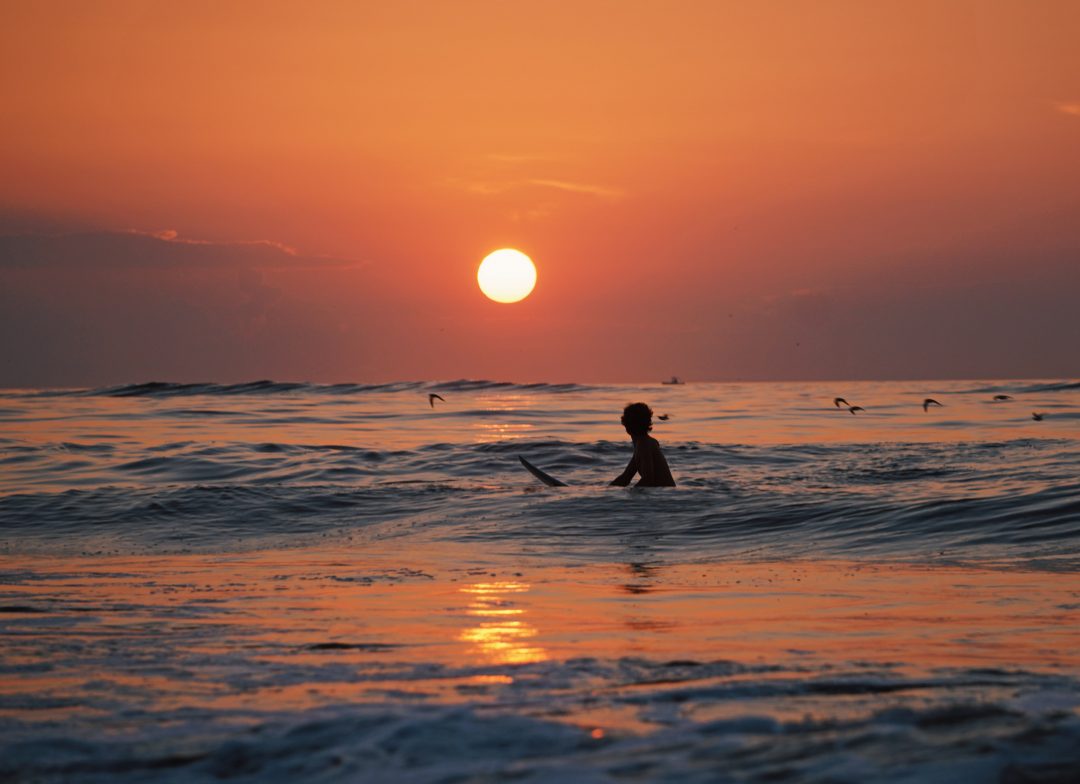
Weather in July: Best Time for a Family Vacation in Costa Rica
Average temperatures: 64F to 82F
July is much like June weather-wise, with a phenomenon called veranillo, or little summer, bringing more sunny days with it. Veranillo is unpredictable, so plan for a continuation of clear mornings and rainy afternoons. Low prices typically continue, and wildlife activity is high, making this one of the best times for families to visit Costa Rica. This is the height of the rainy season along the Caribbean coast so consider planning adventures on the Pacific side, San Jose, or the mountains.
Weather in August: Best Time for Humpback Whale Watching in Costa Rica
Average temperatures: 64F to 82F
Costa Rica weather patterns tend to change this month. The beginning of August often seems like a continuation of July, with more “little summer” sunny days. By the end of the month, though, rainfall increases and it’s clear that the green season has arrived.
Weather in September: Best Time for Caribbean Vacations in Costa Rica
Average temperatures: 64F to 82F
By September, the rainy season is well and truly underway. Don’t let this discourage you, though. September is one of the best times to surf in Costa Rica, and the rafting is excellent this time of year. Since more rain equates to far fewer visitors, this is a great time to save money on everything from adventures to accommodations. If you’re into wildlife watching, you’ll be thrilled to discover that this is also one of the best times to travel to Costa Rica and encounter incredible animals in amazing habitats.
Weather in October: Best Time for Low Priced Vacations in Costa Rica
Average temperatures: 64F to 77F
October represents the height of the Costa Rica rainy season – everywhere but the southern part of the Caribbean coast, that is. During September and October, this typically rainy area often enjoys a reprieve from wet weather, making beachy getaways even nicer. Crowds are smaller, wildlife activity is at its peak, and travelers can continue to find great bargains.
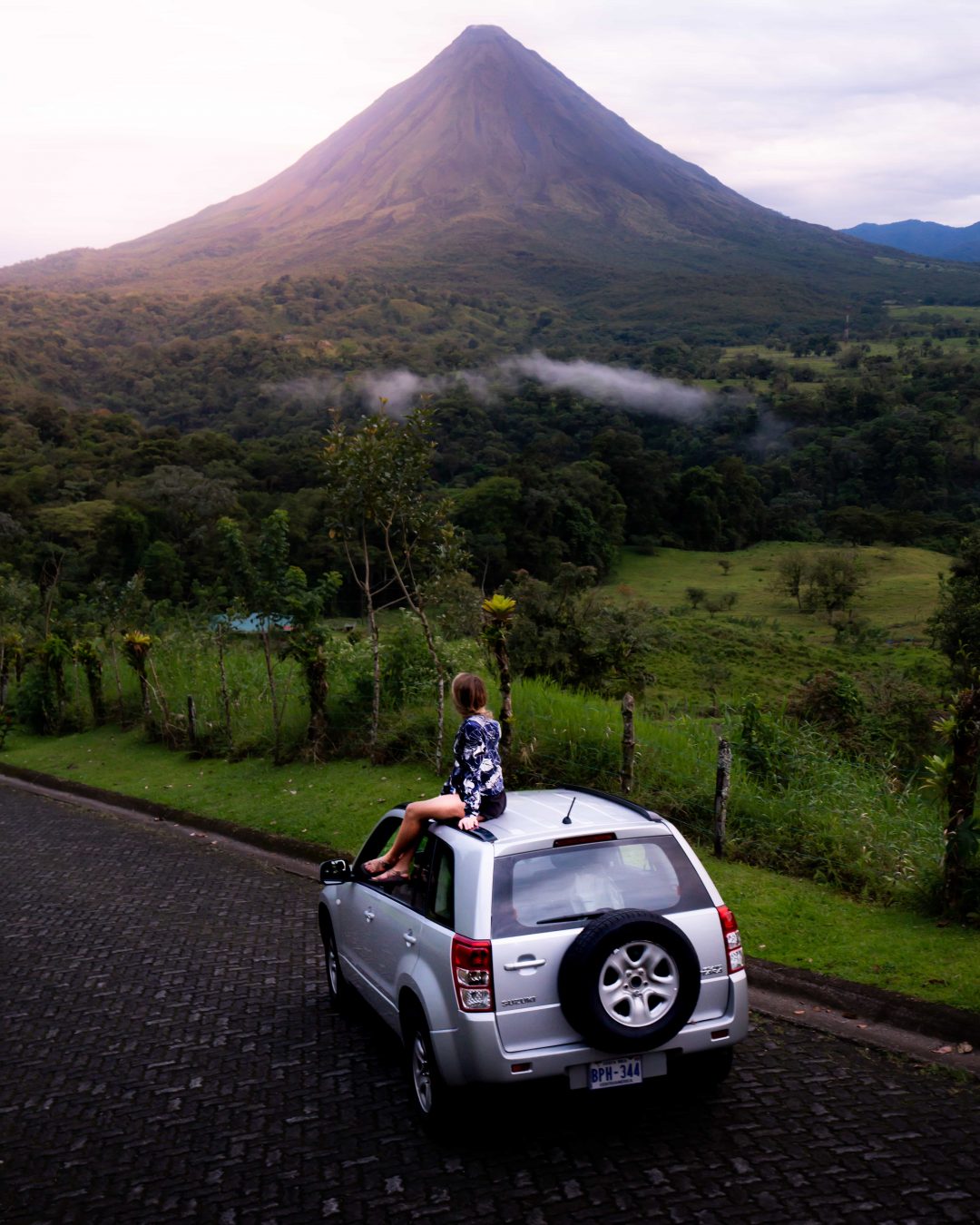
Weather in November: Best Time for Waterfalls, Costa Rica Coffee Tours and Hot Springs
Average temperatures: 64F to 79F
Travel experts call November a bridge month for Costa Rica. Holidays and cold weather in the northern hemisphere are contributing factors to a slight upturn in the number of visitors and less rain has something to do with the phenomenon, too! Since November marks the official end of the Costa Rica off season, you might notice a slight uptick in prices.
Waterfalls are often at their peak in November, and the weather is perfect for soaking in hot springs. If you’re a fan of coffee, now is a great time to see your favorite beans while they’re in the fruiting stage.
Weather in December: Best Time for Flowers, Scenery, and Costa Rica Rainforest Treks
Average temperatures: 64F to 79F
Thanks to less rain and drier Costa Rica weather in December, this month marks a sharp increase in tourism. The beginning of the month often sees a few rainy days, but by the end of December, it’s clear that Costa Rica high season is getting into full swing. It’s once again vital to book accommodations and tours well in advance. Better weather and beautiful holidays see a corresponding increase in prices – but there’s more to enjoy all around the clock. For those hoping to escape winter’s chill, this month is certainly the best time to visit Costa Rica!
The Cheapest Time to Visit Costa Rica
Sometimes the best time of year to visit Costa Rica is also the cheapest! While you might notice some price breaks during rainy months in general, discounts aren’t as prevalent as they once were – mostly because Costa Rica has amazing experiences on offer all year ‘round. In general, you’re more likely to enjoy lower prices between May and June as well as during the months of September and October.

Enjoy beautiful accommodation, coworking spaces, and the ultimate community experience at Selina Jaco!
Peak travel times tend to bring a marked increase in prices. Budget-wise, peak weeks that occur around Christmas and Easter are the worst times to visit Costa Rica. They’re also most crowded. If this is the only time you can visit, be sure to plan at least a year in advance since hotels fill up fast. Simply opting to travel a few days before or after peak times can make a difference in crowd size and cost.
Whatever your destination, look to Selina in Costa Rica. With convenient locations throughout the country, we offer a blend of comfortable, affordable accommodations and experienced local guides who know where surfers can find the best waves, where wildlife aficionados can encounter the species they long to see, and much more. If you’re a digital nomad, you’ll love the fact that Selina offers comfortable co-working spaces with all the high-speed internet you need to complete your tasks before (or after!) hitting the beaches and exploring the rainforests. Whenever your personal best time to visit Costa Rica happens to be, you’ll find memorable ways to enjoy the lush terrain, stunning beaches, and exciting cultural activities.


